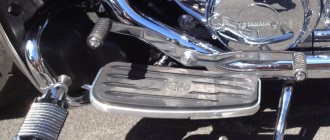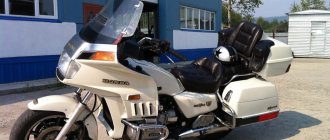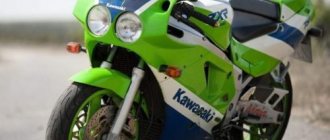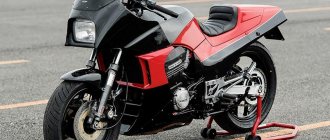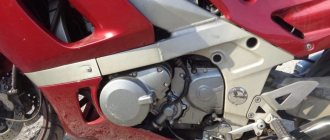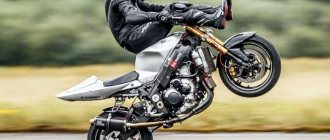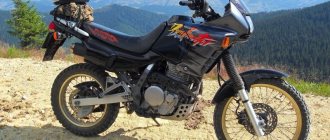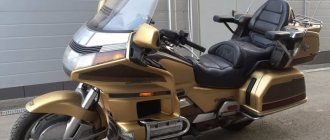YAMAHA sport touring motorcycles
Search by parameters
Motorcycle yamaha fjr1300a
Motorcycle Yamaha FJR1300A
Price: RUR 1,199,000 Out of stock
Yamaha sports and touring motorcycles
Recently, motorcycle enthusiasts have shown increasing interest in Yamaha sports and touring motorcycles. This type of vehicle provides the opportunity to make dynamic trips along city roads and go on long journeys. Sports touring vehicles were created specifically so that you don't have to choose between different types of motorcycles.
Motorcycle characteristics
Yamaha sports touring motorcycles ideally combine the qualities of a sports and touring version. This model range has its own characteristics, such as:
Rigid chassis.
A unique dashboard that shows all the necessary information about the vehicle, right down to tire pressure.
Unique motorcycle design, equipped with four levers.
Anti-lock braking system, which allows you to maintain vehicle controllability in all situations.
Reinforced fork.
The motorcycle is equipped with an intelligent control system that allows you to remotely control the vehicle.
To provide additional driver comfort, the windshield is electrically operated.
Easy handling.
Comfortable fit.
History of Yamaha sports and touring motorcycles.
The world-famous company Yamaha has been producing sports and touring motorcycle models since 1984. Despite the fact that the first version of the motorcycle of this class had large dimensions and considerable weight, it was able to gain popularity around the world. Since this design was not without its drawbacks, two years later the company released a new version of the motorcycle. To this day, the manufacturer is designing new and improving existing models of sports and touring motorcycles.
Buying a sports touring motorcycle
If you are planning to buy a Yamaha sports touring motorcycle and you have many questions, then you can call the phone number listed on our website and qualified specialists will give a comprehensive answer to all your questions.
You can purchase the model you like either in cash or by bank transfer. A flexible pricing policy and a large assortment of models allows everyone to choose the right model. Yamaha sports and touring motorcycles have the best price in the region
Choosing a mid-size sports tourist is, I admit, quite a difficult matter, because there are not so many options and at the same time, each has its own distinctive features. I would like to note right away that everything voiced in this article is my personal opinion, I am not imposing it on anyone, but simply suggest that you familiarize yourself with my research and opinions on this issue, maybe this will help you in choosing a “new favorite”. I became a biker spontaneously, but at the same time deliberately. I won’t go into the details of purchasing my first bike, the only thing I want to note is that it was a red-headed SUZUKI RF400V from 1996. Yes, yes, also a sports tourist. No matter how much I was drawn to sportbikes, I firmly decided for myself - only a sports tourist: a successful combination of a sporty appearance in a plastic body kit, good dynamics and comfortable rides both in the city and on the highway. So, after selling RF glasses, I began to intensively study the reviews and characteristics of different versions of bikes, and already in the first week two favorites appeared - Honda CBR600F4I and SUZUKI GSX650F, but later everything turned out to be completely different... Below is my comparative analysis of the most popular in Russia mid-cc sports tourers in full plastic: HONDA CBR600 F4I, SUZUKI GSX650F, BMW 800ST, YAMAHA FZ6R, HONDA CBR600 F 2011, HONDA VFR 800VTEC.
HONDA CBR600 F4I
Briefly about the bike: In-line engine 109 hp, 599 cc. dry weight 167.8 kg, tank 18 liters, speed up to 251 km/h Modified Honda CBR 600F4, where electronic high-pressure fuel injection appeared. In some countries it was sold in two versions - regular and sports versions. The main differences of the Sport: a separate two-section seat, the absence of a handle on the tail and a central stand. The fuel injection system improves fuel delivery performance and extends the engine's rpm range, while delivering better throttle response, economy and lower emissions. The model turned out to be very successful and quickly conquered the markets of the USA and Eurasia. The famous sports “brother” - the CBR600RR has always had many fans, but not all of them were ready for Super-sport, so they chose the F4I. The bike is equipped with clip-ons, which gives its appearance more sportiness. Personally, I find clip-ons more convenient, but to each his own...
“pros” + the bike is very flexible, forgives mistakes of beginners + powerful engine for a 600 cc tourist + good “readable” dashboard + a wide variety of plastic colors + ideal for the city, not bad on the highway + the bike is very popular, so there are problems with spare parts and With rare exceptions there is no need for repairs + generally reliable
“cons” - it was discontinued in 2006, therefore you can’t buy a “fresh” device - it’s quite difficult to find an “unworn” bike, the best option here is probably due to the “bump” - one headlight is low, the second is high, It doesn’t look very aesthetically pleasing - the main problems are electronics
Price tag: 2005 - 2006 in good condition during the season will cost 250,000-270,000
SUZUKI GSX650F
Briefly about the bike: In-line engine, 85 hp, 656 cc, dry weight 216 kg, tank 19 liters, speed up to 215 km/h Although the bike is externally similar in size to the CBR 600F4I, the greater dry weight is primarily due to the steel frame , this is a kind of “trick” of some Suzuchi bikes. The RF bikes also have a steel frame, it didn’t bother me too much, and the greater weight gives the bike, with proper control, greater stability on the track. The model itself was born in 2007, and when developing the model, the designers tried to combine Katana, Bandit, GSX-600, GSX-1000K5. People called it NEdoJixer, since the plastic is very similar, and the dynamics of the models are “heaven-earth”. Restyling took place in 2009. Controls in the form of a classic steering wheel. Although I am a supporter of clip-ons, I would like to note that of all the models with a classic steering wheel discussed here, this option seemed to me the most convenient.
“pros” + ideal for beginners with brains in their heads + attractive price tag for “fresh” bikes + Japanese reliability + convenient location of the tachometer and speedometer
“cons” - rather weak engine - really crunchy seats - there is no temperature scale on the dashboard, only a light that reacts “after the fact” - after a 400 cc sport or sports tourer, the model will not cause great admiration.
Price tag: In general, you can find a couple of decent options for 2008-2009 for 220,000 - 230,000, 2010 from 260,000
BMW F800ST
Briefly about the bike: In-line 2-cylinder engine, 85 hp, 800 cc, dry weight 182 kg, tank 16 liters, speed up to 220 km/h. Structurally, the bike differs from competitors both technically and externally. Let's start with the fact that in-line two are rarely found on more or less recent models of bikes, therefore we can conclude that other manufacturers do not like it. In addition, BMW specialists, to give stability and combat vibrations, inserted a pseudo-connecting rod into the engine, moving in a perpendicular plane, + or – it’s difficult to judge. Another difference is the tank under the saddle - yes, yes, you really sit on the “fuel”, but this made it possible to lower the center of gravity. A cantilever pendulum and a belt instead of a chain are exactly those “badges” that, probably, as conceived by BMW engineers, should make your long-distance motorcycle travel hassle-free, and operation in the city even more comfortable, because the belt is changed every 40,000 km and does not require from the chain to regular lubrication. A very controversial point for many bikers is the separate switches. I personally was not comfortable after a long experience with the classical scheme. The original side cases are telescopic, this allows you to play with their sizes – it’s convenient. Controls: classic steering wheel.
“pros” + ideal for beginners with brains + very rich equipment: ABS, anti-skid, heated grips, navigation, saddlebags + center stand in combination with a cantilever swingarm + belt drive + low center of gravity + attractive price tag for “fresh” bikes + fuel consumption in Moscow is ~ 6 liters, on the highway 4.5. + A4 lamp in the headlight.
“cons” - frankly rather weak engine - non-standard engine, in which case repair problems may arise - judging by reviews on the Internet, questionable reliability - lightweight, directional stability largely depends on the tires chosen by the owner - separate turn signal switches - inconvenient dashboard - external looks like an amateur, according to my monitoring, it is quite difficult to sell it - service and spare parts are mainly from the officials, as a result of the price, sometimes “space” ....
The price tag for 2007-2008 ranges from 230,000 - 270,000, 2009 can be found for 300,000 - 320,000.
YAMAHA FZ6R
Briefly about the bike: In-line engine, 85/98 hp, 600 cc, dry weight 198 kg, tank 17.4 liters, speed up to 250 km Unlike the famous R6, the Yamaha FZ6R is designed more for comfort rather than track racing. The handlebars are close enough, the saddle is soft, and although the knees feel a little uncomfortable due to the placement of the feet, the overall ride is comfortable. This model is aimed more at first-season riders, so the front brakes here are soft (to minimize the possibility of wheels locking and a beginner flying onto the asphalt), however, more tenacious brakes would be more appropriate... Now eggs and tomatoes may fly at me, but still I I’ll say... When I see this bike, the phrase immediately pops up in my head “... gave birth to either a son or a daughter...” The designers have made this bike so sophisticated that outwardly it’s like a sport, but technically (including a weak engine ) a road worker, and at the same time he is a mediocre road worker... In motorcycle dealerships he is classified into different classes - both super-sport :) and a sports tourist, and a road worker. The appearance is for a special fan: the headlight is stolen from Jixer, the mirrors stick out almost half a meter and the muffler hidden somewhere in the trim is a fart without any comment at all. The classic steering wheel, in my opinion, does not fit into the design of this model at all.
“Pros” + Very attractive price + Yamaha, that is, Japanese quality
“Cons” - the appearance is for a special fan - an unsuccessful dashboard - after a 400 cc sport or sports tourer, this bike will be boring - the standard muffler is very quiet, which significantly reduces passive safety - a large assortment of bikes imported to the Russian Federation, therefore, when subsequently sold to you you have to either make a good discount, or hang a bunch of goodies on it - not “UniSex” - more suitable for girls.
Price tag: 2008-2009 230,000 – 250,000, 2010-2011 260,000 – 290,000.
HONDA CBR600F (from 2011)
Briefly about the bike: In-line engine, 102 (restyler - 85 hp), 599 cc (restyler 649 cc), dry weight 194 kg, tank 19 liters, speed up to 255 km/h. This is a kind of attempt at reincarnation the mega-successful CBR600F4I in the past, and the Japanese were in a hurry to release this model for two reasons - a relatively free niche and the presentation of two variants of the Honda Hornet in 2011. As a result, the bike was nicknamed “Hornet in plastic.” Structurally and externally, the similarity with the Hornet is obvious, although Honda developers deny this. Overall, the new F-glass turned out to be a pretty successful city bike that can get through any traffic jam without any problems. The sporty appearance (many even confuse it with super-sport) is supported by clip-ons and compact mirrors, which significantly distinguishes it from its closest competitors - Yamaha FZ6R, Kawasaki ER-6 and Suzuki GSX650F, and a comfortable fit, good handling, and an abundance of useful options could to make this bike mega-successful, if not for the price... By the way, since 2014 the model has undergone restyling, the engine capacity has become 650 cubic meters, and its power, on the contrary, has dropped to, it seems, 85 horses. If you choose this model, then in my opinion it is better to take 2011-2013.
“pros” + modern appearance with a super-sport bias + reliable, time-tested engine + ABS on almost all produced bikes + made in Italy (it seems the restyler will be made in Malaysia) + inverted fork + fully customizable suspension + clip-ons instead of handlebars + really bike-like handling + large fully electronic dashboard + easy to find a bike in good condition + no drilling of plastic required when installing sliders + reliable + head light with H4 lamp
“cons” - price - unified for sports tourists: a specific mounting system for panniers, especially side cases - quiet standard muffler, which negatively affects passive safety - judging by the market, many people take this model for 1-2 years, but there are very many offers it’s not enough and it’s in vain to count on a good discount - often they sell almost new bikes with standard Batlax tires, which are better to change right away...
Price tag: 2011 ~330,000, 2012 ~350,000, 2013 ~380,000.
HONDA VFR800
V-shaped engine, 109 hp, 782 cc, dry weight 218 kg, tank 21.8 liters, speed up to 265 or 276 km/h (various data) The bike is a legend of motorcycle construction + also a Honda. In principle, the brief description could end here, but if we compare, then we compare models :) So, the history of the model goes back to the distant 1982 (VFR750), the most common generation in Moscow now is the sixth (from 2002). V.). In general, this bike is thought out to the smallest detail - the Dual Combi Brake combined brake system (you press the rear brake, both wheels slow down and the bike seems to squat) together with ABS works wonders on the track. A very convenient and informative dashboard makes it easy to read information at any speed. The console pendulum and central stand allow you to quickly and anywhere carry out maintenance. work related to oil changes and chain lubrication. Its brutal appearance and powerful dual muffler under the tail make it stand out from the crowd. The optics here are also at their best; instead of the usual combination, 2 near lamps + 2 distant lamps are used here. in 2004, the Japanese improved the main problems, but VTEC still remained slightly “jerky”, as it turned on and off at 6800 rpm. In 2006, another restyling was carried out and the VFR became flawless. Now VTEC turns on at 6600 rpm and turns off at 6100 - this allows you to create smooth dynamics of acceleration and braking; the connection of the cylinders can be felt only by noise. The appearance has been changed: the exhaust pipe trims have become matte, and the brake fluid control tanks are gray.
In principle, the brief description could end here, but if we compare, then we compare models :) So, the history of the model goes back to the distant 1982 (VFR750), the most common generation in Moscow now is the sixth (from 2002). V.). In general, this bike is thought out to the smallest detail - the Dual Combi Brake combined brake system (you press the rear brake, both wheels slow down and the bike seems to squat) together with ABS works wonders on the track. A very convenient and informative dashboard makes it easy to read information at any speed. The console pendulum and central stand allow you to quickly and anywhere carry out maintenance. work related to oil changes and chain lubrication. Its brutal appearance and powerful dual muffler under the tail make it stand out from the crowd. The optics here are also at their best; instead of the usual combination, 2 near lamps + 2 distant lamps are used here. in 2004, the Japanese improved the main problems, but VTEC still remained slightly “jerky”, as it turned on and off at 6800 rpm. In 2006, another restyling was carried out and the VFR became flawless. Now VTEC turns on at 6600 rpm and turns off at 6100 - this allows you to create smooth dynamics of acceleration and braking; the connection of the cylinders can be felt only by noise. The appearance has been changed: the exhaust pipe trims have become matte, and the brake fluid control tanks are gray.
“pros” + “the best sport among tourists, the best tourist among sports”© - a popular truth. + Powerful V-shaped engine with 109 horsepower + Dual Combi Brake + ABS (optional) + powerful headlight optics + built-in turn signals (it’s cool that nothing sticks out anywhere) + brutal appearance and 2 exhaust pipes + central stand combined with a console pendulum + excellent handling in the city (including on Moscow aisles in traffic jams) + excellent handling on the highway, one might say rushing like a tank and the wind is not a hindrance to it + with a rear seat cover, it masquerades well as a super-sport + mega-reliable (if you try and find good copy) + it is not necessary to install direct flow, standard pipes are well modified for excellent sound + with the original central trunk the passenger is very comfortable
“Disadvantages” - the bike is a sport-tourer, it is very difficult to find an unworn version. I’ll admit right away that I was looking for my bike from mid-December to early April, during which time I reviewed 12 options. — due to its weight, it is demanding on tires (although the already aged “Mishka Pilot 2” copes with this task perfectly) — the bike is 100% sports touring, while the exhaust system pants go very low, thereby lowering the ground clearance. It won’t be difficult to hook the pipes of a homemade asphalt “speed bump” in the yard. — radiators are on the sides, it’s better to install sliders or a cage, otherwise even with a small fall there is a risk of getting stuck for expensive repairs... — heavy exhaust pipes located under the tail + a tank of almost 22 liters raise the center of gravity by almost 22 liters — 5th generation options suffer from a number of problems (electrics, starter, generator, valve adjustments, etc.). On the specialized forum of the VFR Club, someone even joked that “the 5th generation is rarely seen on the track lately, more and more are probably being repaired in garages” © - except for one manufacturer (SG), all other sliders require replacement or resoldering coolant tank, so if the bike has sliders, I advise you to check how they are installed so that there are no “surprises” on the long journey
I SUMMARY:
As I wrote above, at the beginning I had two favorites, but I didn’t know what exactly I wanted.
Therefore, I approached the choice of the second bike very responsibly - I spent enough time reading articles and comparing reviews, and as a result, through studying and test drives, I created a specific list for myself, divided into 2 budgets (for different loans). Naturally, I set the focus to No. 1 on the list, but also decided that I would look in parallel to No. 2 - suddenly, there would be problems with finding a VFR800 in excellent condition and I wouldn’t find anything until “day X” (I chose April 15). The list of priorities turned out like this: Budget 270,000 rubles 1) VFR 800VTEC 2005 stock from behind the hill or 2006, mainly requiring investments of ~10-15 tr) 2) CBR 600F4I 2006 with goodies from behind the hill 3 ) GSX 650F 2009 with ABS and some other goodies 4) BMW F800ST 2007 with ABS, heated grips, looking for Germany. I completely abandoned the YAMAHA FZ6R for the reasons described above. I didn’t consider the KAWASAKI ER6 at all - I don’t like it, and Kava’s reputation in Russia is not very good...
Budget 350,000 rubles 1) VFR 800VTEC 2008 with niceties such as a central case, Mishka Pilot 2 or 3 tires, heated grips and sliders 2) CBR 600F 2011 2012 with an alarm, forward flow and a mileage of about 10,000 km. with a budget of 350,000, there is no point in looking at the other options listed above.
PLEASE NOTE that the prices are as of March-April 2014 in the Moscow region, in Vladivostok you can find cheaper or more complete ones, but delivery to Moscow costs 15,000 - 20,000 + the purchase itself turns out to be like fortune-telling by reading coffee grounds.
My new favorite:
modified exhaust:
I've already driven >3000 km, happiness from realizing the right choice knows no bounds)))
PS : Dispelling MYTHS: While reading a bunch of articles and hundreds of reviews, I noticed that: 1) many bikers complain either about the weight of the bike or about taxiing at near-zero speeds. This is especially true for the VFR 800, because it is the heaviest of all of the above. So, except for a smile, such comments do not cause anything, because reading these lines written by the guys, I remember how young miniature girls with clothing sizes 40 - 42 “on the Mountain” easily control the 267 kg VFR1200 and the same VFR800... Conclusion: guys , these are all “cockroaches in your head”, make friends with them :) Otherwise, what you are afraid of is what worries you. All the listed bikes handle excellently, there are no problems with weight anywhere, and on the same VFR in a dense traffic jam you can freely maneuver between the rows at 40-60 km/h. 2) poor directional stability on crushed stone and when the asphalt is removed, it slips on the markings. Here I agree partly: the markings in Moscow are really slippery when wet, and even more so with shampoo... Otherwise, look at your tires - you save when buying, you pay for it when using them. I drove on different tires and was personally convinced of this. Conclusion: Do you have problems with directional stability? Check the tires for wear and the manufacturer. For a sports tourist, the best tires are Mishka Pilot 3 or 4; if you don’t have enough money, the best option would be Mishka Pilot 2.
That's all! Well done for finishing reading! I hope this helped in some way!
Good luck!
I will be grateful for your feedback and criticism. Together we can make this article as comprehensive and useful as possible for those who are currently looking for
First achievements
In 1987, Yamaha released its legendary sports motorcycle FZR 1000 Genesis.
Its 4-cylinder engine produced 136 hp. The same year, the motorcycle won the prestigious Castrol Six Hour race in Australia. In 1995, production of the FZR 1000 ended and was replaced by the more powerful YZF1000r Thunderace.
Today, the FZR 1000 is positioned more as a sport-tourer due to its more upright riding position and higher front fork rake than modern sports bikes, making it comfortable for long-distance riding.
In addition to factory tuning, you can install pistons and a crankshaft from the YZF1000R Thunderace, increasing engine power to 145 hp, but such a conversion on FZR1000 motorcycles is impractical due to the high price of spare parts.
If you want to enter the world of liter motorcycles without spending a lot of money, then the FZR 1000 is the motorcycle for you. But don’t forget about the age of the motorcycle, and even if you have a trouble-free motorcycle from Japan, you will still have to spend money on maintenance.
YAMAHA FZR motorcycles are represented by the following line: FZR250, FZR400, FZR600, FZR750, FZR1000.
Second generation
In 1996, the YZF1000R Thunderace was released. Distinctive features of this motorcycle are: Deltabox aluminum frame, 4-piston front brakes, adjustable suspension, increased tank volume to 20 liters. Engine power was 145 hp. Experts immediately noted that this bike is difficult to control because it is large and heavy (224 kg). Sales fell, so the company developed the YZF-R1 in 1997.
Since 1998, the YZF1000R Thunderace has been positioned as a sports tourer, and in 2001 it left the production line.
Model range: YZF1000R Thunderace, YZF600R Thundercat.


